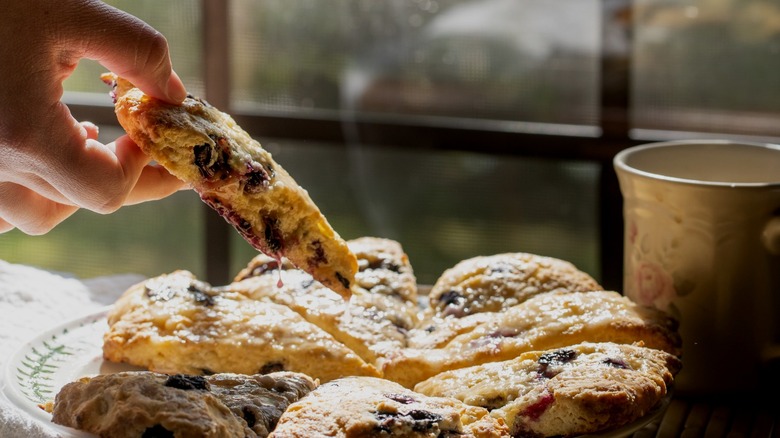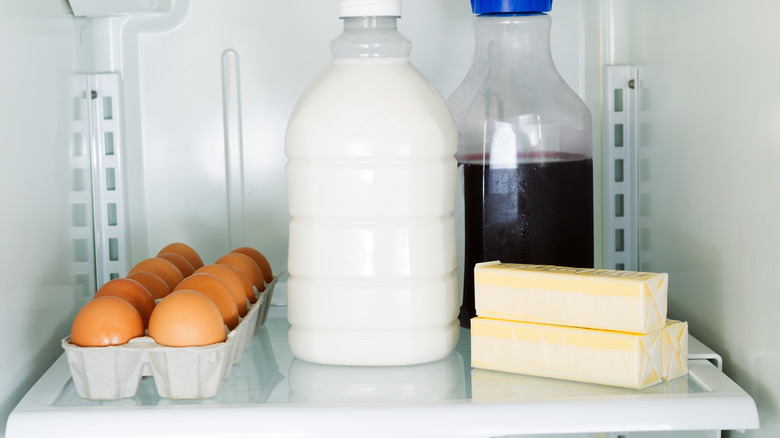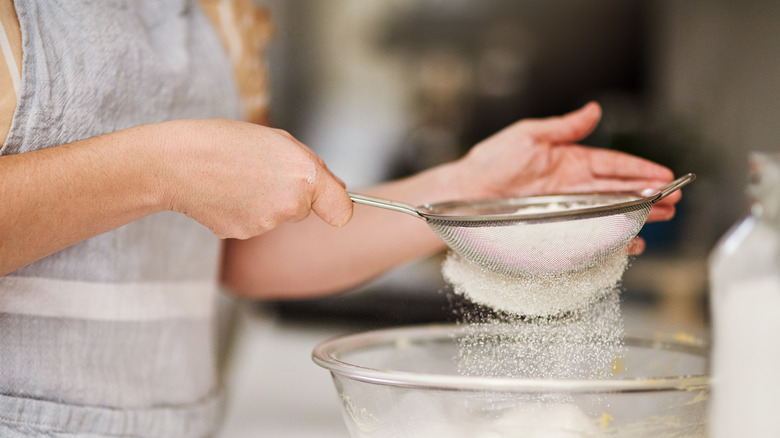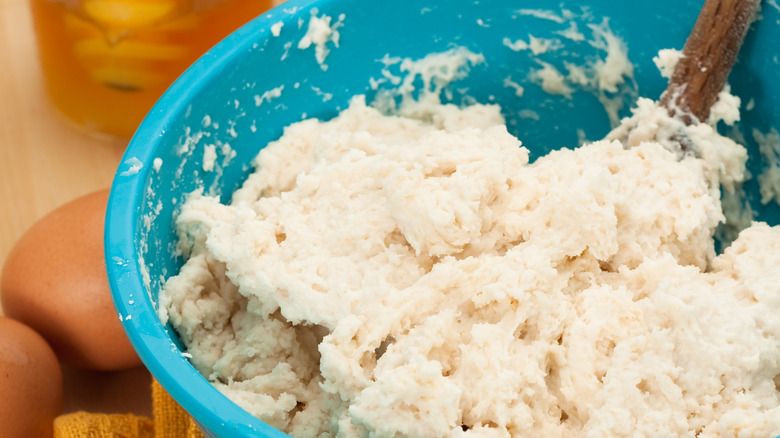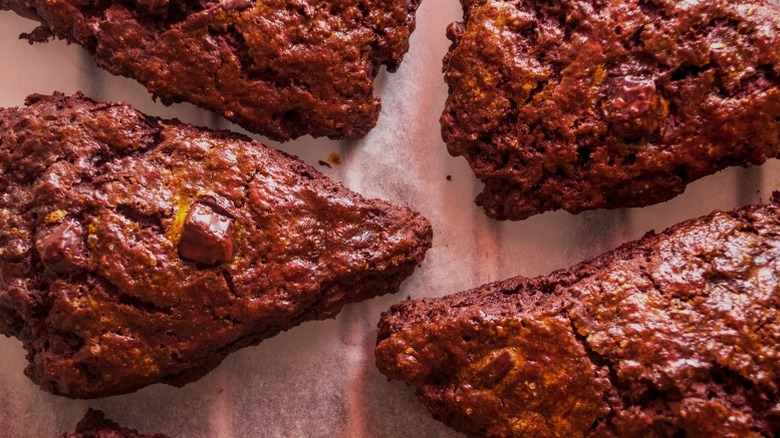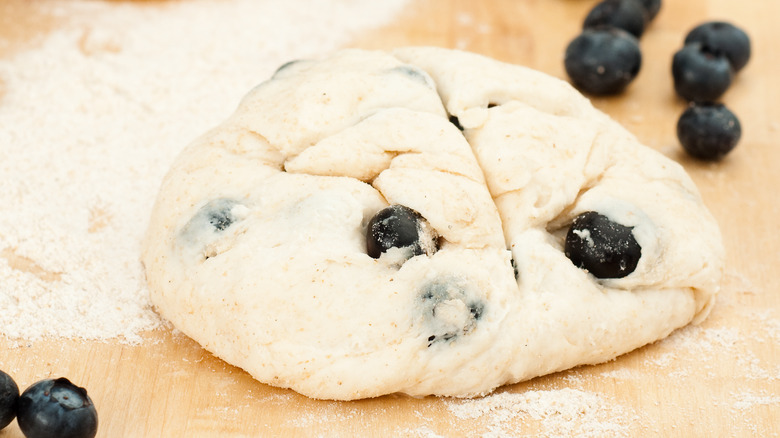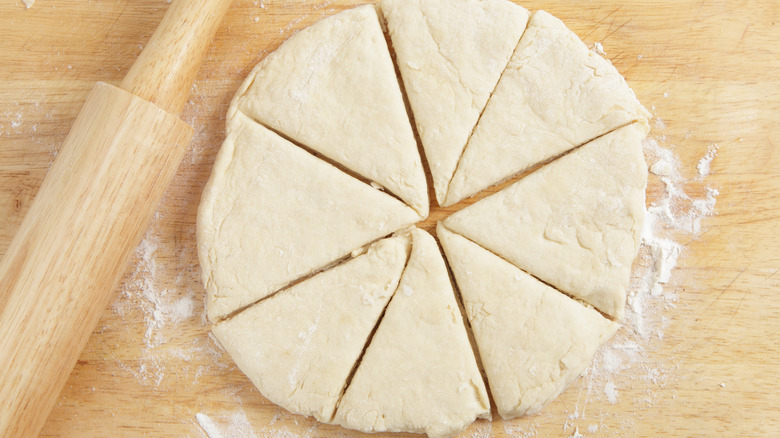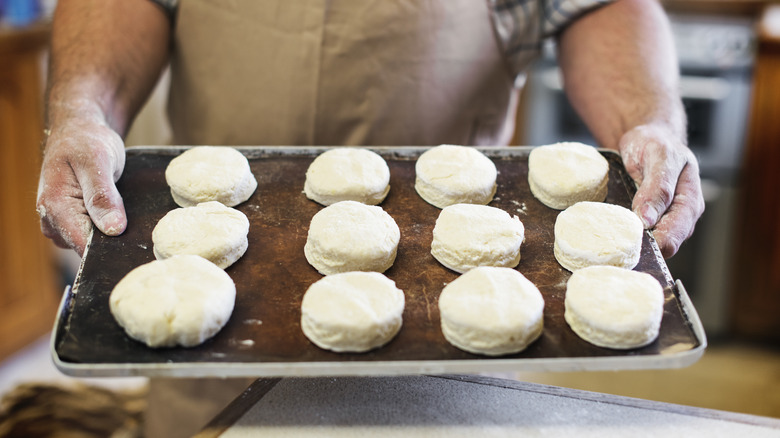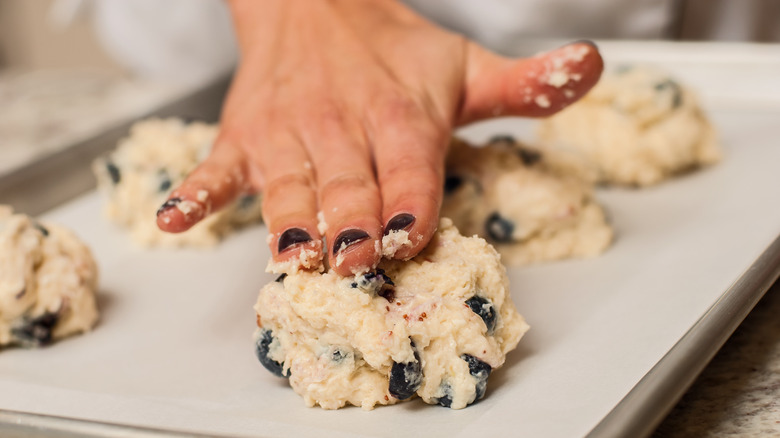12 Tips To Help You Become A Scone-Making Master
Few pastries are as timeless and versatile as a light, buttery scone that you can enjoy with a steaming cup of joe or afternoon tea. The perfect scone has a crispy, browned surface that draws you in and a fluffy crumbly texture that keeps you coming back for more. Typically, these lovely baked goods are made with flour, sugar, leavening agents, butter, sugar, and some type of milk; a pinch of salt and an egg or two doesn't hurt, either. In fact, it's the addition of sugar and eggs that differentiates scones from biscuits.
You might think that making scones is a walk in the park as long as you have a simple and polished formula. However, before you begin your baking journey, it's important to know some specific tips regarding making scones so that you end up with the perfect result. Because if you whiz past certain steps, the scones may become tough or rubbery, which is a major letdown when you're looking forward to tender and delicious baked goods.
1. Use cold ingredients
When you pick your beloved scone recipe, do yourself a favor and take the instructions seriously in terms of ensuring that certain ingredients are chilled. It is essential to ensure that the butter is cold. You can even freeze it beforehand if you decide to bake scones on a warm day. In addition to the butter, the liquid ingredients, such as buttermilk, milk, or half-and-half, need to be very cold when you use them, so do not remove them from the refrigerator until you are seconds away from mixing them into the dough.
Not every scone recipe calls for eggs, but if yours does, the same rule also applies to them. Additionally, it's always a good idea to put your baking tools or bowls in the refrigerator beforehand because the chilled equipment prevents the butter from melting. If you use this tip, you're likely to end up with restaurant-quality scones: You'll never return to using room-temperature ingredients again. The cold ingredients make for a solid dough that rises perfectly, and the cold butter creates extra flaky layers of pastry.
2. Grate the butter
The best way to break down the butter for your scone recipe is to grate it: Grating prevents the butter chunks from being too large. You can use a box grater to accomplish this, and it is much easier if you freeze the butter first because it grates as effortlessly as cheese, and it doesn't melt in the process. If you don't own a cheese grater, simply should chop the butter into tiny cubes to achieve a similar effect. Whichever route you take, you must ensure you don't throw large pieces of butter into the dough. If the butter doesn't spread evenly, you may end up with uneven and dry baked goods.
When the fat from the butter comes in contact with the flour proteins, it prevents the dough from turning stiff. In other words, the butter creates a block so that the liquids can't affect the gluten and further develop it, which helps the dough rise. Steam forms when the butter softens in the oven; this action aids the baked good in springing up. Evidently, the best way to guarantee the scones are rich and crumbly in the best way possible is to integrate small pieces of butter throughout the dough.
3. Sift the dry ingredients
If you want fluffy scones, one of the best things you can do is sift the dry components before you mix anything into them. Sifting does a couple of things simultaneously: Firstly, it aerates the flour and leavening agents. The more air the dry mixture has, the lighter the end product is. Secondly, aside from its textural benefits, sifting helps ensure that all the dry components are evenly distributed into each other, which is an excellent way to avoid uneven baking.
For instance, if you make a batch of scones that requires 1 tablespoon of baking powder and you simply toss the measured baking powder into a bowl of flour (and don't sift them all together), the leavening agent may not evenly spread throughout the flour when you mix them. Hence, a number of scones from that batch might be short on baking powder and bake incorrectly.
One thing to consider when you sift flour and all the other dry ingredients is whether or not you should sift before or after you measure them. Most of the time, you measure first and then sift after. However, if the recipe states calls for "1 cup sifted flour," then you need to use the sieve first. As with any other baking practice, the order in which you do things is crucial in determining how the scones turn out, so it's important to read your recipe diligently.
4. Slowly add the milk
While you should follow a recipe to you make homemade scones, it is important to use your discretion and assess the dough's consistency before you bake it. The dough doesn't need to be super sticky for this type of pastry. Instead, the mixture needs enough fluid ingredients for it to just come together. Therefore, you should add a portion of the buttermilk or milk to the dough first. Then, add small amounts of buttermilk until the dough turns from a crumbly mixture to a large mass that you can form. It's also important to check the bottom of the bowl. Sometimes, it appears the dough has formed, but there is a decent amount of dry floury pieces at the base of the bowl, so you need to incorporate those in too.
Subsequently, you might need more liquid to compensate for those extra crumbs. Once you have a dough ball, you don't need to add any remaining milk. Sometimes, you'll find that you don't need the whole amount of liquid that the recipe calls for. So, if you had initially dumped all of the milk in at once, the dough would've been much too wet to work with (the pastries don't hold their shape when this happens). Ultimately, this simple step helps you avoid tough scones, so take your time when you add the milk.
5. Don't overmix the dough
The last thing you want is a dense scone, so avoid kneading the dough too much. Kneading is vital with other types of bread because you want to develop that chewy texture and strength in the crumb. Gluten strands begin to form when you add liquid to flour, then they continue to do so when you mix and work the dough. So, it becomes stiffer every time you fold an additional ingredient into the dough or knead the completed dough on the counter.
Scones are a type of quick bread, and they have a different makeup than, say, French bread or sandwich bread; they are meant to be more cake or biscuit-like in terms of consistency, and they don't go through a proofing process. Hence, you don't want to disturb the gluten too much with this baked good. Overworking the gluten for softer bakes is a huge mistake because it destroys the tenderness. As the gluten strands tighten, the dough becomes less pliable and easily rips when you roll it out. In the end, it is okay if your dough isn't entirely smooth, so don't worry about getting every little lump out.
6. Experiment with flavors
Classic scones have a simple base that isn't overly sweet, so they're perfect for mixing in various different ingredients. Many people enjoy various different scone flavors, from fresh blueberry scones to white chocolate cranberry scones. If you'd like to make your scones more exciting, you can always change the base of the scones for a unique taste or experience. For instance, you can get creative and make sourdough scones, which are extra fluffy.
Sourdough starter contains yeast, which helps the baked goods rise. Additionally, if you end up with extra sourdough starter, you can use it for a bread recipe instead of throwing it out, so you get the best of both worlds. This rendition is especially lovely if you like the taste of sourdough bread: Sourdough scones have a similar taste with tangy undertones.
You could also make brownie scones, which have a chocolaty base and are much more decadent than the mildly sweet traditional scone. Brownie scones are perfect for folks who like dessert pastries. The possibilities are endless when it comes to scones: You can make any flavor, ranging from pumpkin to red velvet and more. It is best to find a recipe and follow the proper ratios so your baked goods are flawless.
7. Add mix-ins last
Regardless of which mix-ins you opt for to make scones, it's always a good idea to fold them gently into the dough. Some ingredients, like fresh berries, burst or break easily, and their extra liquid creeps into the dough. If you're adding fresh or frozen fruit, it's best to do this as the last step so the juices don't have too much time to melt and mingle with the flour, butter, and other ingredients in the dough. Otherwise, the fruit's liquid affects the overall thickness of the dough and sometimes turns the scones gray, making them look old and unappetizing.
There are some key moisture tips to remember before adding fresh fruit to scones. You should rinse, drain, and dry fresh fruit before you use it in the recipe, which will help remove extra moisture. Harder elements such as nuts or chocolate chips should also be added last, especially if you use a tabletop mixer instead of making the dough by hand. Those machines can crush smaller components in seconds, so use the lowest speed and only mix it until the ingredients cling to the dough. As long as you follow these tips, your extra ingredients will likely remain in one place and will not ruin the look or texture of the pastry.
8. Add a light sprinkling of flour to the work surface
One of the significant differences between baking and cooking is that baking is a much more precise process: Exact measurements of ingredients are essential to ensuring baked goods turn out well. For this reason, it's essential to ensure you don't add too much flour to your work surface, as it can easily sneak into the dough. You definitely do need some flour on the table when you roll out the scones. Otherwise, the dough becomes a sticky mess quite quickly, and it can be difficult to pick up the raw dough when it sticks to the counter.
However, it is best to lightly sprinkle the area as you roll and turn the dough. If you find that the dough is beginning to stick, you can always sprinkle in some more. But, whatever you do, don't begin with a thick blanket of flour because it makes the dough tough, which makes it harder for you to roll it out. If you cut the scones with a round biscuit cutter instead of slicing them into triangles, you can collect the scraps and re-roll them to avoid food waste. However, if you add too much flour to the surface, the scape will be quite unusable.
9. Chill the scones after cutting them
Although you might want to transfer your newly cut scones directly to the oven, it's best to take a detour and allow them to sit in the refrigerator first. When you mix the dough, the butter often softens due to many factors, like the warmth of your hands or the room-temperature air. To achieve flaky scones, it is beneficial to place the scone dough into a chilled environment, allowing the temperature to reduce. This way, the scones will likely bake uniformly, allowing them to rise and brown at the same time.
Additionally, since the dough contains gluten, chilling the scones lets the gluten take a breather, so you end up with softer scones. You don't need to wait around for hours, either (unless you want to, of course). You only need to chill the scones for about ten minutes. You can probably hold off on preheating the oven until you chill your scones. This way, your kitchen will not heat up as you're making the recipe, and the appliance can heat up while the scones rest.
10. Brush the tops of the scones
It's important to brush the scones with egg wash for presentation and texture purposes. If you have never worked with egg wash before, don't worry: It's actually pretty easy to heat up. All you need to do is beat one or two whole eggs with a whisk or fork until the whites and yolks combine. Then, add 1 tablespoon of liquid per egg: You can use milk, cream, or even water. The egg wash helps give the scones a gorgeous golden color as they bake, making them look more refined and appealing. Brushing the scones with egg wash creates a thin crust on the top layer of the pastry. You're aiming for scones that have a crunchy exterior and pillowy center.
Some bakers don't use egg wash. Instead, they brush the baked goods with a different ingredient, like milk or buttermilk. Whichever liquid you choose can really impact the quality of the end product. Just make sure you don't brush the scones with too much liquid. If it begins to run down the sides, it might prevent the scone from rising successfully because the liquid seals the dough when it hardens.
11. Don't crowd the pan
Since the leavening agents and the butter in the scones rise significantly during the baking process, they need adequate room to do so. After you cut the scones and allow them to rest in the refrigerator or freezer, it's important to line them up on a sheet tray and space them out. Try to leave at least 1 inch between each scone so that they can bake evenly on all sides and thoroughly in the center. Furthermore, this step prevents the scones from baking into each other, leading to one large scone that doesn't bake all the way through.
If you make a big batch of scones, you might need to break up the dough and bake it for a few different rounds. Of course, if you have multiple baking pans, you are at an advantage because you can spread the baked goods onto different pans and bake them all at once. Make sure not to overbake the scones: Follow the recipe's suggested time and remove the scones from the oven once they're golden brown.
12. Eat them fresh
You shouldn't bake scones ahead of time: Scones taste best when they're fresh, unlike some other sweet treats that arguably taste better on the second day (or even a few days) after you bake them. Many baked items, like cheesecake or bread pudding, taste wonderful after the flavors and ingredients have had plenty of time to combine together. Those types of baked goods have a completely different set of elements than scones, though. Because of the texture and composition of scones, it doesn't take long for them to taste stale, so you should enjoy them the same day you bake them. The crumb of scones is pleasantly soft when they come out of the oven, but the longer they sit, the quicker the delicate and flaky properties will diminish.
If you want to plan ahead when you bake, you're not alone; there are ways to work around this. First, make the dough as usual, cut it, and then transfer the ready-to-bake pastries to the refrigerator or freezer. Then, when you're ready to bake the scones, remove them from their chilled storage space. This method actually works out quite well since the dough should be mixed anyway. Also, you can bake the exact number of scones you plan to consume and save the rest of the dough batch and bake it the next time you want to make scones.
